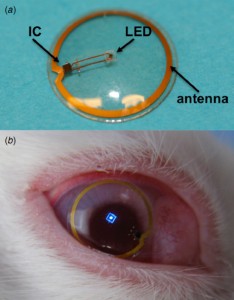The next step in Google’s cyborg plans: Smart cont
2014-05-27 00:00
288 查看

Share This article
Google X, the secretive research lab famed for its work onGlassand Google’s self-driving cars, has unveiled its next product: Smart contact lenses. The first smart contact lens, aimed at diabetics, takes a glucose level reading every second from the tears that wash over your eye when you blink, and transmits that data wirelessly to a nearby device. Google doesn’t say what device, but presumably a smartphone or Google Glass. Yes, if Google X has its way, we will soon all look like cyborgs, our bodies becoming interconnected networks of implants and augmentations.Currently, if you have diabetes, you generally have to perform finger-stick blood tests throughout the day. At best this is inconvenient, at worst it’s disruptive and painful — but either way, if you want to safely manage your blood sugar levels, it must be done. Due to the inconvenience factor, though, many diabetics don’t test themselves as often as they should — which then leads to all sorts of nasty situations, such as passing out. There are other ways of reliably testing blood sugar levels, such as your tears — but, as you can imagine, collecting tears is no easier than pricking your finger. Unless you have a smart contact lens…

Concept art for a multi-pixel wireless contact lens display.
With Google’s smart contact lens equipped, if your glucose level dips or spikes, a warning can be transmitted instantly to a nearby display — your smartphone, smartwatch, or head-mounted display (Google Glass). Future versions of the smart lens might even have a built-in LED that lights up if your glucose level crosses above or below a given threshold. This is obviously much easier and convenient than regularly sticking your finger. (Read: What is transhumanism, or, what does it mean to be human? )

Single pixel contact lens display, in a rabbit’s eye.
While it might sound incredibly advanced, the technology in Google’s smart contact lens isn’t that wild. There’s basically just two components, sandwiched between two layers of contact lens material: An antenna and rectifier, and a small glucose sensor. The problem with smart contact lenses, though, is the power source. Google glosses over this point because the current solution is rather ungraceful: Wireless power transfer from a nearby power source. Because of the tiny antenna, the power source probably has to be very close. Google Glass would work — though, at this point in its development, we’re probably not talking about anything nearly as graceful — it’s probably just stationary lab test. (Diabetics strapped to a chair, contact lens inserted, and then tested.)
The good news is, Google X has the best person in the world when it comes to smart contact lenses — Babak Parviz. Way back in 2011, Parviz made a wireless smart contact lens with a single-pixel LED display (pictured right) Google X was obviously impressed with his work and picked him up. Smart contact lenses, due to rather unique placement — they’re able to see the world, and display information to the wearer — are one of the most exciting areas of cyborg implantation and augmentation . Their one weakness is that they are heavily constrained by their size and transparency requirement. Still, if Google X can find a graceful way of powering smart contact lenses, this could be a very exciting endeavor indeed.
相关文章推荐
- (论文阅读) The Next Step In Web Services
- Ballmer: Investing in the Next Decade of Growth and Opportunity
- The first step of my life in the EC field
- com.google.gwt.user.client.rpc.IncompatibleRemoteServiceException: This application is out of date, please click the refresh but
- Coding in the Shade: Using Eclipse with Google Data APIs
- Security and Versioning Models in the Windows Forms Engine Help You Create and Deploy Smart Clients
- The Guy Who Ran Microsoft And Google In China Clones US Startups
- [转]Google in the middle
- Including custom text in the step "User Decision"
- Day in the Life of a Googler
- The Words You Must Known Typed In Google
- My map in the Google
- Bike fly in the Google Earth
- 10 Skills Developers Will Need in the Next Five Years
- Problems and Projections in CS for the Next 49 Years
- Catching the "Home" key press in Smartphone.
- Describe the T codes step wise in Asset Accounting module.
- Google Advertising Tools: Cashing in with Adsense, Adwords, and the Google APIs [ILLUSTRATED]
- What did Google change in the kernel?
- Step-by-step guide to installing the Automatic Image Slider w/ CSS & jQuery from Soh Tanaka in Zen Cart
